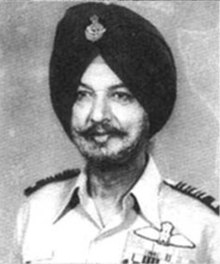For the singer, see Dilbagh Singh (singer). For the Olympic athlete, see Dilbagh Singh Kler.
| Air Chief MarshalDilbagh SinghPVSM, AVSM, VM | |
|---|---|
 | |
| 12th Indian Ambassador to Brazil | |
| In office August 1985 – August 1987 | |
| Appointed by | President of India (then, Zail Singh) |
| Preceded by | S.S. Nath |
| Succeeded by | A.R. Kakodar |
| 25th Chairman of the Chiefs of Staff Committee | |
| In office 31 July 1983 – 3 September 1984 | |
| President | Zail Singh |
| Prime Minister | Indira Gandhi |
| Preceded by | K. V. Krishna Rao |
| Succeeded by | Oscar Stanley Dawson |
| 11th Chief of the Air Staff (India) | |
| In office 1 September 1981 – 3 September 1984 | |
| President | Neelam Sanjiva Reddy Zail Singh |
| Prime Minister | Indira Gandhi |
| Preceded by | Idris Hasan Latif |
| Succeeded by | Lakshman Madhav Katre |
| Personal details | |
| Born | 10 March 1926 Rahon, Jalandhar district, Punjab |
| Died | 9 February 2001(2001-02-09) (aged 74) Dehradun, Uttarakhand, India |
| Military service | |
| Allegiance | |
| Branch/service | |
| Years of service | 1945-1984 |
| Rank | |
| Unit | No. 1 Squadron |
| Commands | Eastern Air Command Ambala Air Force Station 28 Squadron |
| Battles/wars | Indo-Pakistani War of 1965 Indo-Pakistani War of 1971 Operation Lal Dora |
| Award(s) | |
Air Chief Marshal Dilbagh Singh, PVSM, AVSM, VM (10 March 1926 – 9 February 2001) was the head of the Indian Air Force from 1981 to 1984, as Chief of the Air Staff. He was the second Sikh to hold that position.
Dilbagh Singh was commissioned as a pilot in 1944. His operational flying career spanned the Spitfire to introducing the MiG-21 into service in India. He had earlier made the first official "supersonic bang" over India in New Delhi when the Mystere IV-A was showcased in a public demonstration.
He was India's ambassador to Brazil from 1985 to 1987. He was a student of pandit Buta Ram of Rahon. His visit to Rahon to visit his teacher when he was Air Marshal is still remembered. He inspired scores of youngsters from Rahon and Nawanshahar region to join defense forces
References
- "Air Marshal Kumaria Visits Air Force Station Chandigarh To Felicitate its 50 Golden Years". 1 March 2011.
- "Dilbagh Singh". Bharat Rakshak. Archived from the original on 7 April 2017. Retrieved 8 April 2018.
- "rediff.com: Air Chief Marshal Dilbagh Singh no more". www.rediff.com. Retrieved 28 May 2020.
External links
- Ex-Air Chief Dilbagh Singh dead, The Tribune, 11 Feb 2001
- Air Chiefs, www.bharat-rakshak.com
- Sikh Pilots in the Indian Air Force in World War Two, www.bharat-rakshak.com
| Military offices | ||
|---|---|---|
| Preceded byIdris Latif | Chief of the Air Staff (India) 1981–1984 |
Succeeded byLakshman Katre |
| Chief of the Air Staff of the Indian Air Force | ||
|---|---|---|
| Air Marshal Commanding, Royal Indian Air Force (1947–1948) |  | |
| Chief of the Air Staff and Commander-in-Chief, Royal Indian Air Force (1948–1950) | ||
| Chief of the Air Staff and Commander-in-Chief, Indian Air Force (1950–1955) | ||
| Chief of the Air Staff (1955–present) |
| |
| (**Seconded from the Royal Air Force) | ||
This Indian military-related biographical article is a stub. You can help Misplaced Pages by expanding it. |
This Indian diplomat-related article is a stub. You can help Misplaced Pages by expanding it. |
- 1926 births
- 2001 deaths
- Chiefs of Air Staff (India)
- Indian Air Force air marshals
- Indian military aviators
- Punjabi Sikhs
- Military personnel from Punjab, India
- Ambassadors of India to Brazil
- Recipients of the Param Vishisht Seva Medal
- Recipients of the Ati Vishisht Seva Medal
- Recipients of the Vayu Sena Medal
- National Defence College, India alumni
- Indian military personnel stubs
- Indian diplomat stubs
- People from Punjab Province (British India)
